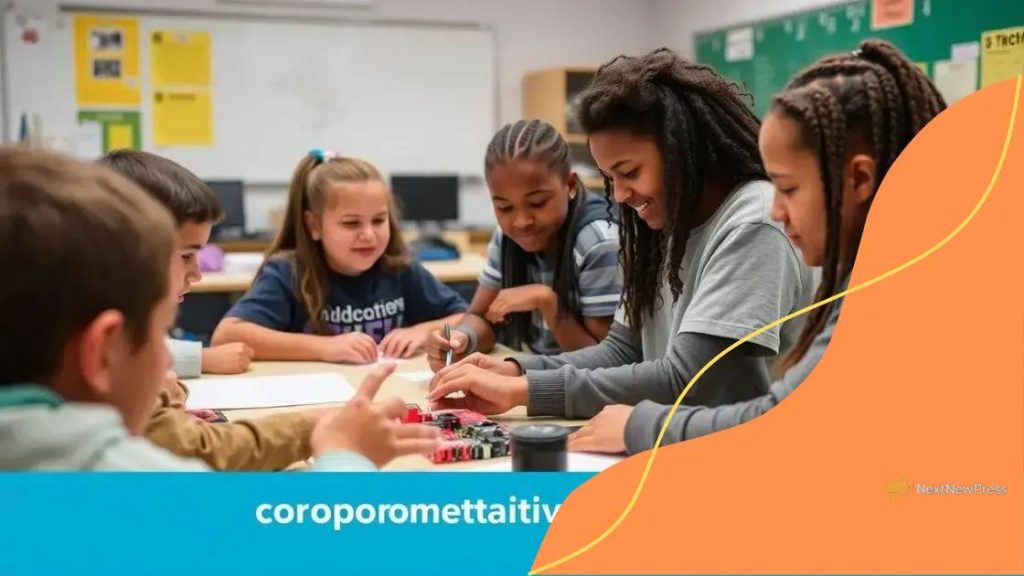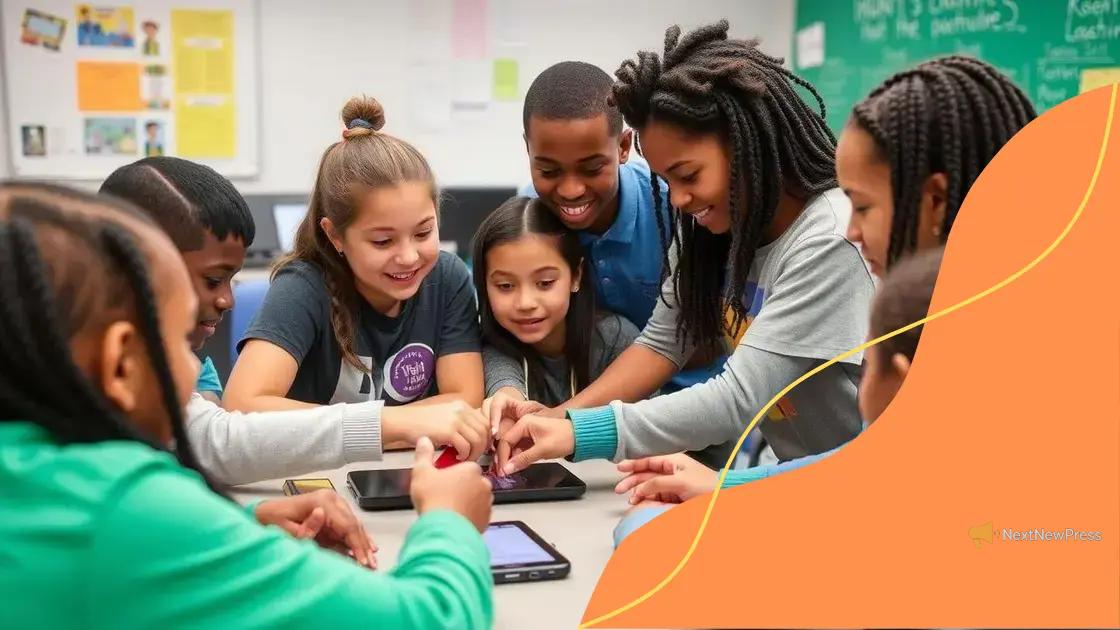Fostering computational thinking skills across the curriculum

Fostering computational thinking skills across the curriculum enhances problem-solving abilities, promotes student engagement, and prepares learners for technology-driven futures by integrating real-world applications and collaborative learning strategies into various subjects.
Fostering computational thinking skills across the curriculum can transform how students engage with their learning. Have you ever wondered how these skills can enhance creativity and problem-solving? In this article, we will delve into effective methods for incorporating these vital skills into everyday lessons.
Understanding computational thinking
Understanding computational thinking is essential for students in today’s digital world. It involves a problem-solving process that helps learners break down complex tasks. By grasping the components of this thought process, students can improve their analytical skills and creativity.
Key Concepts of Computational Thinking
Computational thinking includes several core concepts. It encourages students to think logically, analyze problems, and devise solutions systematically. Let’s explore some of these concepts:
- Decomposition: Breaking down a problem into smaller, manageable parts.
- Pattern Recognition: Identifying similarities and differences within data sets.
- Abstraction: Focusing on the important information while ignoring irrelevant details.
- Algorithms: Creating a step-by-step strategy to solve a problem.
By integrating computational thinking into everyday learning, educators can provide students with vital tools for success. This skill set promotes creativity and enhances problem-solving abilities, guiding students in different subjects.
Importance in Education
Incorporating computational thinking enhances educational outcomes. It allows students to become better learners and prepares them for future careers. Learning to think computationally encourages collaboration, allowing students to work together on projects.
When students engage in group activities that involve computational thinking, they learn to voice their ideas and share perspectives. For example, in a science class, students could create simulations to understand natural phenomena, promoting curiosity and enthusiasm.
Ultimately, understanding computational thinking is fundamental for modern education. As technology continues to evolve, equipping students with these critical skills has never been more important. Taking the time to foster these competencies ensures that students are not only prepared for academic challenges but also capable of thriving in a digital society.
Integrating computational thinking into various subjects
Integrating computational thinking into various subjects is crucial for developing well-rounded students. This approach encourages learners to apply their skills across different disciplines, making learning more meaningful and cohesive. Teachers can seamlessly weave computational thinking into subjects like math, science, and even the arts.
Examples in Different Subjects
In mathematics, students can use computational thinking to solve complex problems. By breaking down equations into smaller steps, they can better understand the process. Science classes provide opportunities to create simulations, allowing students to analyze results and draw conclusions.
- Math: Use algorithms to solve word problems.
- Science: Model real-world phenomena through coding.
- Language Arts: Organize ideas using programming techniques.
- Art: Create digital artwork using logic and coding.
Implementing computational thinking in these subjects fosters creativity and critical thinking. It encourages students to see connections between topics, enhancing their overall learning experience. For instance, in a history lesson, students could analyze data trends or create timelines using programming tools. This not only helps visualize information but also promotes engagement and exploration.
Benefits of Integration
The integration of computational thinking leads to numerous benefits. Students develop problem-solving strategies and gain confidence in their abilities. Furthermore, this method encourages collaboration among peers, as they often work in groups to tackle projects.
By building these essential skills, students are better prepared for the workforce of the future. As technology advances, the demand for individuals who can think computationally will only grow. By making these skills part of everyday learning, educators play a vital role in shaping the next generation.
Benefits of fostering these skills in education

Benefits of fostering these skills in education are immense and can significantly enhance students’ learning experiences. By encouraging computational thinking, educators empower students with vital competencies that extend beyond traditional subjects. These skills promote creativity, logical reasoning, and problem-solving abilities.
Enhanced Problem-Solving Skills
One major benefit is the improvement in problem-solving skills. When students learn to analyze problems methodically, they become more effective in finding solutions. This ability is essential not just in academics but also in real-world scenarios.
- Critical Thinking: Students learn to evaluate information carefully.
- Adaptability: They become more flexible in their thinking, allowing for innovative solutions.
- Collaboration: Working in groups enhances their ability to communicate and share ideas.
- Confidence: Mastery of skills leads to increased confidence as they tackle challenges.
Fostering these skills also prepares students for future careers. In a world where technology continues to evolve, being able to think computationally is a significant advantage. Students who practice these skills are often better equipped to adapt to changes and solve complex problems in the workplace.
Increased Engagement in Learning
Another key benefit is the increased engagement in learning. When students use computational thinking, lessons become more interactive and exciting. They are more likely to take an active role in their education, leading to higher retention rates of the material being taught.
For instance, in a coding activity, students not only learn programming but also apply mathematical concepts in a fun and engaging way. This deepens their understanding and makes learning enjoyable.
Additionally, fostering these skills nurtures a growth mindset among students. They begin to recognize that challenges are opportunities for learning, which encourages perseverance and resilience. As students embark on this journey, they not only gain knowledge but also develop a mindset that values continuous growth.
Practical strategies for teachers
Practical strategies for teachers can effectively integrate computational thinking into the classroom. By adopting specific methods, educators can enhance student engagement and foster essential skills. Here are some practical approaches that can be easily implemented.
Use of Real-World Problems
One way to incorporate computational thinking is through real-world problems. Teachers can present challenges that require students to use logic and reasoning to find solutions. This approach makes learning relevant and exciting.
- Case Studies: Analyze case studies that require critical thinking.
- Simulations: Create scenarios that mimic real-life situations.
- Data Analysis: Teach students to interpret data from their everyday life.
- Project-Based Learning: Encourage students to work on projects that address real issues.
Incorporating these elements helps students connect classroom learning to their lives, enhancing their interest and investment in the material.
Collaborative Learning Opportunities
Encouraging collaboration among students is another effective strategy. Group work fosters teamwork and communication skills, crucial components of computational thinking. When students work together, they share diverse perspectives and develop solutions as a team.
For example, group projects can involve coding, designing a game, or developing a model. Through collaboration, students not only learn from one another but also strengthen their problem-solving abilities.
Moreover, integrating technology can amplify collaboration. Tools like online forums, shared documents, and coding platforms allow students to work together, even from different locations. This also prepares students for future workplaces, where teamwork and technology go hand-in-hand.
Challenges and solutions in implementation
Challenges and solutions in implementation of computational thinking in education can pose obstacles to teachers and students alike. While fostering these skills is essential, various difficulties may arise during the integration process. Understanding these challenges helps educators to devise effective solutions.
Common Challenges
One major challenge is the lack of training for teachers. Many educators feel unprepared to teach computational thinking effectively. This can lead to frustration and ineffective implementation in the classroom. Additionally, limited resources, such as access to technology, can hinder the ability to incorporate these concepts into lessons.
- Teacher Training: Insufficient professional development opportunities can leave educators feeling unsupported.
- Resource Availability: Not all schools have the latest technology or materials needed for hands-on activities.
- Curriculum Constraints: Rigid curricula may not leave room for innovative teaching methods.
- Student Engagement: Some students may struggle to see the value of computational thinking in their lives.
These challenges require thoughtful solutions to ensure that computational thinking is implemented effectively in classrooms. Addressing each issue is crucial for creating an engaging learning environment.
Implementing Effective Solutions
To overcome the obstacles mentioned, schools can focus on providing targeted professional development for teachers. Workshops that emphasize computational thinking strategies are valuable for enhancing educators’ confidence and skills. Additionally, schools should explore partnerships with local businesses or community organizations to improve access to technology and resources.
Another effective strategy is to adapt curricula to include computational thinking. Teachers can integrate these concepts into existing subjects, making the learning experience more relevant. By using project-based learning, students can engage with real-world applications of computational thinking.
Moreover, involving students in the process can boost engagement. Educators can seek student input on projects and activities, allowing them to connect personally with the material. This fosters a sense of ownership over their learning, significantly impacting their motivation.
FAQ – Frequently Asked Questions about Fostering Computational Thinking in Education
What is computational thinking?
Computational thinking is a problem-solving process that involves breaking down complex problems, recognizing patterns, and developing algorithms.
How can teachers integrate computational thinking into their lessons?
Teachers can use real-world problems, encourage collaborative learning, and incorporate technology to make lessons engaging and relevant.
What are the benefits of teaching computational thinking to students?
Benefits include enhanced problem-solving skills, increased student engagement, collaboration among peers, and preparation for future technology-driven careers.
What challenges do educators face in implementing computational thinking?
Challenges include lack of teacher training, limited resources, rigid curricula, and ensuring student engagement.





